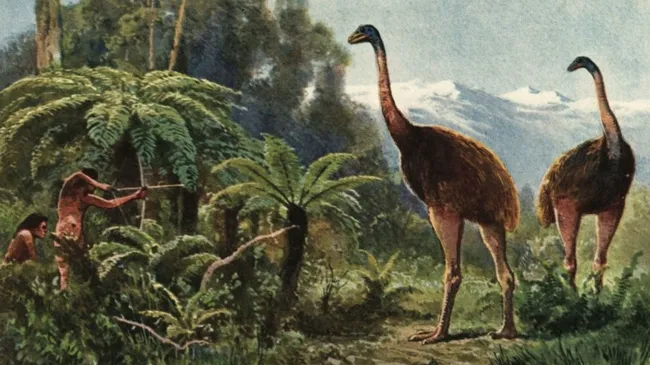The South Island giant moa could be the next species that biotech company Colossal Biosciences “brings back” from extinction — but experts say the result will not and “cannot be” a moa.
Biotech Firm Targets Giant Moa for De-Extinction Effort
A massive, flightless bird that once roamed New Zealand and vanished about 600 years ago is the latest species selected for possible “resurrection” by the controversial biotechnology company Colossal Biosciences.
On July 8, Colossal announced plans to genetically recreate the South Island giant moa (Dinornis robustus), a bird that once stood up to 12 feet (3.6 meters) tall. It was the largest of the nine known moa species, all of which are believed to have been wiped out by human activity.
“We’re reviving avian dinosaurs,” the company declared in an Instagram post.
This isn’t Colossal’s first foray into de-extinction. The company previously announced the return of the dire wolf (Aenocyon dirus), a prehistoric predator from the Ice Age. However, experts pushed back, pointing out that what Colossal had produced were actually gray wolves with selected dire wolf traits. Other species on the company’s resurrection list include the woolly mammoth, the Tasmanian tiger (thylacine), and the dodo—projects that continue to stir scientific and ethical debates.
Trevor Worthy, a vertebrate paleontologist and associate professor at Flinders University in Australia, criticized the moa project in an email to Live Science. “With so many species going extinct today, it’s not acceptable to treat de-extinction as a justification for allowing present-day losses,” he said.
Moa or Moa-Inspired Hybrid?
Colossal’s latest announcement has sparked a wave of criticism from scientists who say the bird produced by the project won’t be a true moa. Instead, they argue, it will be a genetically engineered hybrid with some moa-like features.
“There’s no current genetic technology that can fully restore an extinct species, especially one that has been gone for hundreds of years and is disconnected from its original ecosystem,” said Philip Seddon, a zoologist at the University of Otago in New Zealand. “Whatever emerges from this will not be a moa — it can’t be.”
After Colossal’s dire wolf reveal, the company’s chief scientist, Beth Shapiro, admitted to New Scientist that the animals were really “gray wolves with 20 genetic edits,” and emphasized that “it’s not possible to perfectly bring back an extinct species.” Still, Colossal’s public messaging often seems to suggest otherwise.
In the moa announcement, Shapiro again stated the company would “bring the moa back to life,” while co-founder and CEO Ben Lamm said they aim to “return it back to the ecosystem.”
Seddon pointed out to the New Zealand Science Media Centre (NZSMC) that this latest announcement fails to make clear that the best-case outcome is not a true moa, but an ecological stand-in.
How the Moa Re-Creation Would Work
Shapiro told Time Magazine that the plan involves analyzing DNA from the preserved bones of all nine moa species and comparing it to the genetic sequences of their closest living relatives: emus and tinamous. These birds will serve as modern templates to help reconstruct the moa genome.
“It makes good scientific sense to use tinamous and emus for comparison,” said Worthy. “DNA research has shown that tinamous are moa’s closest relatives, and emus are not far off either.”
Once key moa genes are identified, scientists would edit the DNA of emu or tinamou cells to resemble those of the extinct moa. These engineered cells would then be implanted into surrogate birds, with hopes of producing a living hatchling. According to Colossal, these animals would not be released into the wild or confined to zoos but instead kept within protected reserves.
Worthy added that although these recreated birds might be large and powerful, they likely wouldn’t pose a threat to people unless provoked. “If you startled one or tried to hug it, you’d probably get a hard kick and be seriously hurt,” he said.
A Pathway to Scientific Insight?
Despite the skepticism, some researchers say the effort could still offer valuable insights. Colossal argues that techniques developed during the moa project—like creating artificial eggs—could aid in the conservation of endangered birds.
“There’s no doubt this process will lead to major scientific breakthroughs,” Worthy acknowledged. “We’ll gain an unprecedented understanding of moa DNA and learn more about their evolution and relationships to living species.”
Whether this endeavor will result in a true “resurrection” or simply an engineered facsimile, the debate over de-extinction is far from settled.
